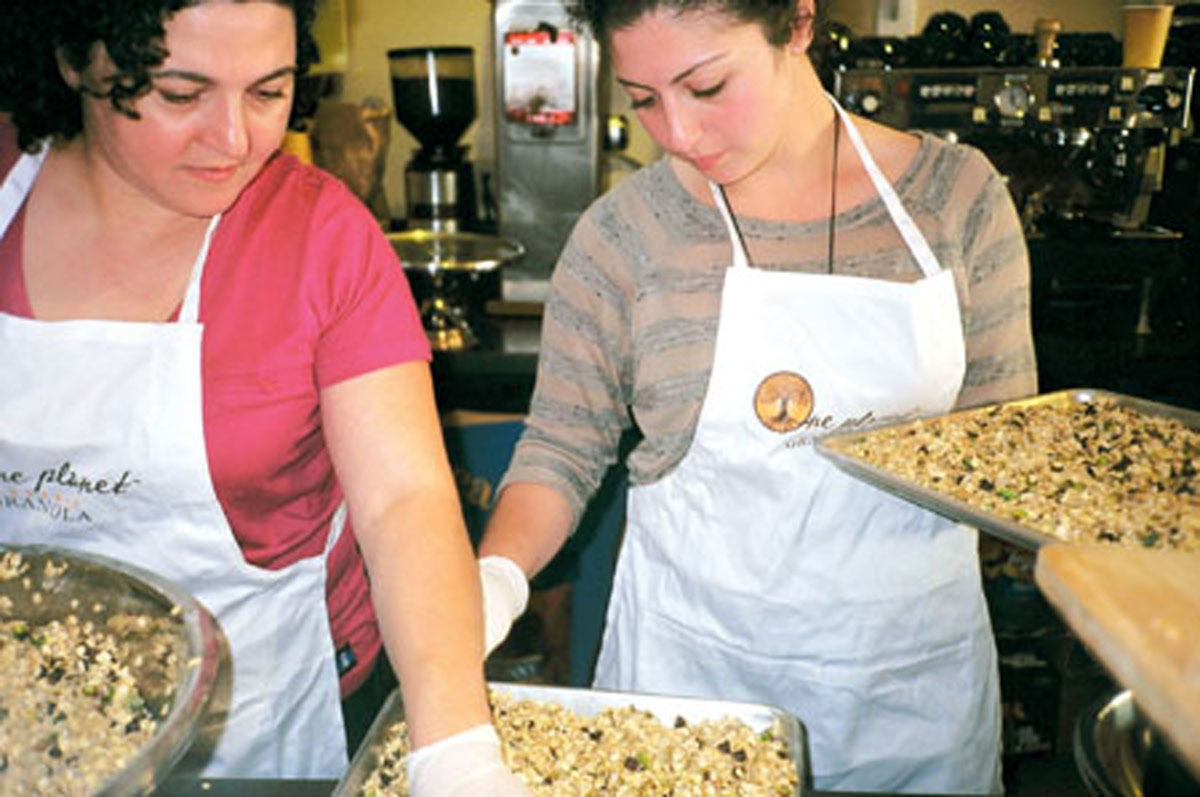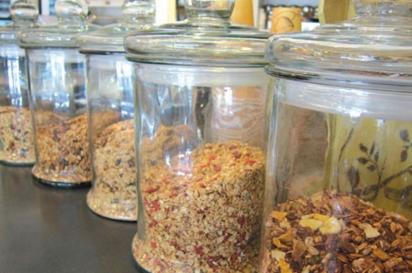Artisan Granola: Big Gains for Grains
Granola. In the 1970s, the word evoked images of Birkenstocked hippies downing pottery bowls of toasted oats, wheat germ, nuts and raisins in flowery meadows.
Not any more. Like many other foods that began as counterculture phenomena 40 years ago, granola has grown up. And based on the number of savvy culinary artisans creating the complex cereal these days, it’s here to stay.
“I’d mention granola and people would say, ‘yuck,’” laughs Novatan Sara Ladd, whose Sonoma-based parents Nancy and Bill Ladd debuted their grain-rich, barely sweetened Nana’s All Natural line of four granolas in 2009. “There’s a real back-to- basics trend going on now,” Ladd continues. “People have come to realize that the ones being made in small batches these days are high in protein and fiber. It’s an easy on-the-go type of snack. It’s fitting back into our lifestyle.”
Though granola still has an image as 20th century hippie food, a cereal by that name actually debuted in the 1870s. It was invented by Dr. John Harvey Kellogg of Battle Creek, Michigan. According to historian Leslie Brenner in American Cuisine, Kellogg believed that people should be eating grains for breakfast rather than heavy meats, so he created a mixture he called granola. It flopped. (His next venture was made from highly processed corn and named Corn Flakes.)
It took 100 years before the back-to-the land movement of the 1970s re-launched the idea of granola. As Americans grew fresh vegetables, explored the “new” idea of seasonal, local cuisine and mastered the art of French cooking, their interest in eating healthier extended to what they consumed in the morning, seeking alternatives to the sugar-heavy, air-puffed, preservative-laden particles being boxed as breakfast by giant companies like Post and General Mills and Kellogg’s, the company founded by Dr. Kellogg’s more entrepreneurial brother W. K.
Granola recipes from 40 years ago show that certain ingredients, such as whole oats, wheat germ, sunflower seeds, raisins, almonds and peanuts were staples. But talk about cloying! Early granolas were drenched in brown sugar or honey. Recipes from the 1970s frequently list a half cup of sweetener along with two cups of oats and a variety of nuts and seeds. You might as well have eaten a bowl of crumbled cookies. One major difference in granolas then and now is the type of sweeteners used. Contemporary small-batch granolas are flavored with organic agave, honey or maple syrup in comparatively miniscule quantities.
“We use only one cup of sweetener to 16 pounds of other ingredients, including 50% fruits, nuts and seeds in each type we make,” says Rana Madanat of Ross. With her daughter, Sandra, Rana debuted the One Planet line of granolas in 2010. “We are rethinking ways to see it. We are even thinking about creating savory versions.”
Other appealing qualities about today’s granolas?
A BAKER’S DOZEN of Artisan Granolas
Here are just 13 of the scores of artisan-made granolas available currently throughout the North Bay. Most are handmade in small batches. Many contain at least 50% organic ingredients. Some are gluten- free and some are even raw. Look for them at a wide range of local markets including Mill Valley Market in Mill Valley, Good Earth Natural Foods in Fairfax, all area Whole Foods Markets, Paradise Foods in Corte Madera and Novato, Woodlands Markets in Kentfield and Tiburon, the three Oliver’s Markets in Sonoma County, Petaluma Market and farmers’ markets throughout the Bay Area.
• Brickmaiden granola, created by Celine Underwood in Point Reyes. This granola is made with organic oats, coconut, sesame seeds, sunflower seeds, almonds, honey, maple syrup, coconut oil, cranberries and raisins. In texture, it’s chunky, with a dry crispness. “It has a low added fat content, so it’s more like a toasted muesli,” says Underwood. Sold at the Sunday Marin Civic Center Farmers’ Market, plus other shops in Marin County.
• Bungalow Munch granola, created by endurance athlete and Iron Man competitor Jeri Howland, in Corte Madera. Jeri makes one flavor of granola using organic oats, maple syrup, unsweetened coconut, sunflower seeds, whole cashews and canola oil. www.bungalowmunch.com
• Café Gratitude granola, made by Café Gratitude and sold at their cafes as well as many Bay Area markets and online. This is a raw, organic granola based on sprouted buckwheat, sprouted almonds, dates, apples, coconut flakes, raisins, agave, vanilla bean, cinnamon and Himalayan sea salt. This is a chewy experience, dense and bar-like in texture. Great for travel. www.cafegratitude.com
• Cibo granola, created by chef/owner Tara Ancona of Cibo Café in Sausalito. This is sweeter than many artisanal granolas, with a rich, nut-like roasted flavor. It was designed, said Ancona, for serving with tangy Straus organic whole milk yogurt and fresh fruit. www.cibosausalito.com
• Flour Craft Gluten Free granola, created by Heather Hardcastle of San Rafael. Heather makes two varieties: Maple Pecan, with organic oats, seeds and more pronounced maple and nut flavors, and Cranberry Almond, with a sweet-salt quality and nice hit of fruit. Look for this at the Thursday Marin Civic Center Farmers’ Market. www.flourcraftbakery.com
• From the Fields granola, created in Mill Valley by entrepreneur and former industrial designer Betsy Fields. From the Fields currently has six varieties, with two more in development. These granolas are unusually flavorful, with lightly sweet/salty finishes. The Local Farm Blend features seasonal fruits, slow-roasted oats, maple syrup and ground vanilla beans. A nut-free version gets its oomph from currants and dates. www.fromthefields.net
• Insalata’s granola, created by chef/owner Heidi Insalata Krahling of Insalata’s Restaurant in San Anselmo. This granola is toasty, with a delicate texture and assertive notes of honey, almond and coconut. www.insalatas.com
• Jimtown Store granola, created by Carrie Brown, founder/ owner of the Jimtown Store in Healdsburg. For her granola, Brown mixes Giusto’s rolled oats with toasted almonds and lots of seeds including flax and fennel, spices, raisins, dried cherries and unsweetened coconut. This granola has an unusual finish from the fennel and cherries. www.jimtown.com
• Lydia’s Lovin’ Foods Organic makes five kinds of sprouted grain and nut granolas, created by Lydia Kindheart of Fairfax. Sprouted ingredients include sunflower seeds, almonds and pumpkin seeds. One version has no sweetener. Others are sweetened with fruit or agave. www.lydiasorganics.com
• Marge Classic American Sweets granola, created by Megan Gordon. Made in Richmond, this granola is sold at the Marin Country Mart Farmers’ Market in Larkspur on Saturdays, and in local stores. Roasted in olive oil and featuring cranberries and pecans, this granola has an almost savory, toasted nutty flavor. www.margebakery.com
• Nana’s Organic Granola, made by Nancy and Bill Ladd of Sebastopol. These are among the least sweet of the granolas listed, with true grain flavor. The Tropic of Ginger is especially distinctive. www.nanasallnatural.com
• One Planet Granola, created by mother/daughter team Rana and Sandra Madanat of the Café on the Common in Ross. These granolas were the most complex I tasted. Most unusual flavors? Chocolate Indulgence, with chocolate, ginger, pistachios, dried bananas and mango; and Berry Happy, a gluten-free mixture with dried mulberries, blueberries, Incan berries and raspberries. This granola is served at Café on the Common and sold at many Bay Area markets as well as online. www.oneplanetgranola.com
• Rustic Bakery granola, created by founder/owner Carole Levalle. This granola is made with whole nuts and has an almost plush mouthfeel. Look for it at the Marin Country Mart Farmers’ Market in Larkspur on Saturdays and also at the Rustic Bakery locations in Larkspur and Novato. www.rusticbakery.com
Many are rife with organic ingredients although the finished granola might not be certified organic. (Look for compostable packaging as well.) A growing number–such as Flour Craft; two of the varieties from From the Fields; and Nana’s All Natural–are gluten-free.
Raw is also catching on. Café Gratitude and Lydia’s Loving Foods are making granolas from sprouted grains and nuts that are slowly baked at temperatures below 118° F.
Contemporary granolas have become the cereal world’s Deluxe Crayola Crayons. The Madanats, for example, use a palette of 40 ingredients to turn out One Planet’s six different granolas. From the Fields’ half a dozen granolas (there are two more in the works), read like a cornucopia. Depending on the variety, you may find quinoa, hemp seeds, peaches, figs, plumps, cherries, pears, apricots, ground vanilla beans and kosher salt.
“Artisan granola is taking off hugely,” says David Canepa, third-generation retailer behind the Mill Valley Market. “In the last year I’ve had individuals making the stuff come to me looking for shelf space right and left. The old companies that have been around for years, they’re just dying. They’re not keeping up with the trends.”
One granola, made by Rustic Bakery, is literally taking off: Virgin Atlantic Airlines serves this Marin-made product in its first class cabins, in a parfait with yogurt and fruit.
If customers take issue with today’s granolas, Canepa says, it’s the perception that they’re fattening as well as expensive. A typical 12-ounce bag of organic granola retails for anywhere from $7 to $11, depending on who makes it. “Hey, what I tell people is, a little goes a long way,” says Betsy Fields of From the Fields. “I say, forget about the fat and eat up. You don’t need more than one or two ounces. It’s good for you.”







